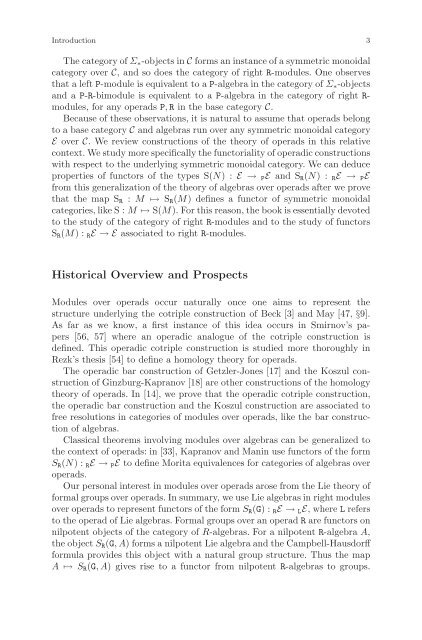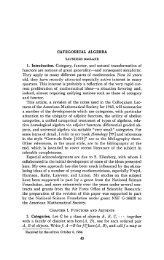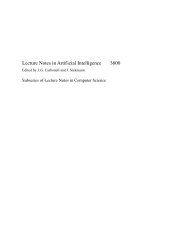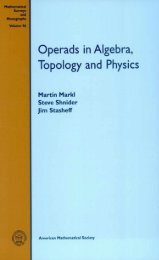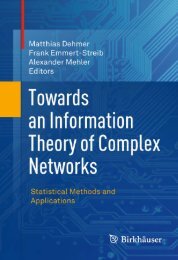Symmetric Monoidal Categories for Operads - Index of
Symmetric Monoidal Categories for Operads - Index of
Symmetric Monoidal Categories for Operads - Index of
Create successful ePaper yourself
Turn your PDF publications into a flip-book with our unique Google optimized e-Paper software.
Introduction 3<br />
The category <strong>of</strong> Σ∗-objects in C <strong>for</strong>ms an instance <strong>of</strong> a symmetric monoidal<br />
category over C, and so does the category <strong>of</strong> right R-modules. One observes<br />
that a left P-module is equivalent to a P-algebra in the category <strong>of</strong> Σ∗-objects<br />
and a P-R-bimodule is equivalent to a P-algebra in the category <strong>of</strong> right Rmodules,<br />
<strong>for</strong> any operads P, R in the base category C.<br />
Because <strong>of</strong> these observations, it is natural to assume that operads belong<br />
to a base category C and algebras run over any symmetric monoidal category<br />
E over C. We review constructions <strong>of</strong> the theory <strong>of</strong> operads in this relative<br />
context. We study more specifically the functoriality <strong>of</strong> operadic constructions<br />
with respect to the underlying symmetric monoidal category. We can deduce<br />
properties <strong>of</strong> functors <strong>of</strong> the types S(N) :E → PE and SR(N) : RE → PE<br />
from this generalization <strong>of</strong> the theory <strong>of</strong> algebras over operads after we prove<br />
that the map SR : M ↦→ SR(M) defines a functor <strong>of</strong> symmetric monoidal<br />
categories, like S : M ↦→ S(M). For this reason, the book is essentially devoted<br />
to the study <strong>of</strong> the category <strong>of</strong> right R-modules and to the study <strong>of</strong> functors<br />
SR(M) :RE →Eassociated to right R-modules.<br />
Historical Overview and Prospects<br />
Modules over operads occur naturally once one aims to represent the<br />
structure underlying the cotriple construction <strong>of</strong> Beck [3] and May [47, §9].<br />
As far as we know, a first instance <strong>of</strong> this idea occurs in Smirnov’s papers<br />
[56, 57] where an operadic analogue <strong>of</strong> the cotriple construction is<br />
defined. This operadic cotriple construction is studied more thoroughly in<br />
Rezk’s thesis [54] to define a homology theory <strong>for</strong> operads.<br />
The operadic bar construction <strong>of</strong> Getzler-Jones [17] and the Koszul construction<br />
<strong>of</strong> Ginzburg-Kapranov [18] are other constructions <strong>of</strong> the homology<br />
theory <strong>of</strong> operads. In [14], we prove that the operadic cotriple construction,<br />
the operadic bar construction and the Koszul construction are associated to<br />
free resolutions in categories <strong>of</strong> modules over operads, like the bar construction<br />
<strong>of</strong> algebras.<br />
Classical theorems involving modules over algebras can be generalized to<br />
the context <strong>of</strong> operads: in [33], Kapranov and Manin use functors <strong>of</strong> the <strong>for</strong>m<br />
SR(N) :RE → PE to define Morita equivalences <strong>for</strong> categories <strong>of</strong> algebras over<br />
operads.<br />
Our personal interest in modules over operads arose from the Lie theory <strong>of</strong><br />
<strong>for</strong>mal groups over operads. In summary, we use Lie algebras in right modules<br />
over operads to represent functors <strong>of</strong> the <strong>for</strong>m SR(G) :RE → LE, whereL refers<br />
to the operad <strong>of</strong> Lie algebras. Formal groups over an operad R are functors on<br />
nilpotent objects <strong>of</strong> the category <strong>of</strong> R-algebras. For a nilpotent R-algebra A,<br />
the object SR(G,A) <strong>for</strong>ms a nilpotent Lie algebra and the Campbell-Hausdorff<br />
<strong>for</strong>mula provides this object with a natural group structure. Thus the map<br />
A ↦→ SR(G,A) gives rise to a functor from nilpotent R-algebras to groups.


